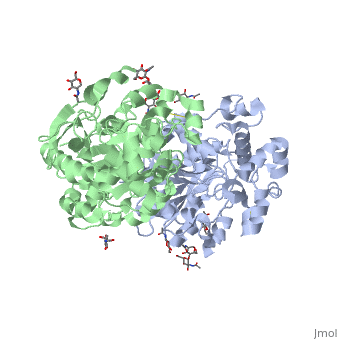Sandbox 78
From Proteopedia
/>
IntroductionHuman gastric lipase (HGL, E.C. 3.1.1.3) (PBD ID: 1hlg) is a type of lipase (of the enzyme class hydrolase) that is responsible for initiating the digestion of dietary fats in the stomach [1]. This pH-stable enzyme is secreted by the fundic chief cells of the human stomach and catalyzes 10-20% of total lipolytic processes (i.e., those involving fat breakdown) in healthy adults [1]. HGL specifically catalyzes the hydrolysis of triacylglycerol in order to produce diacylglycerol and a carboxylate byproduct [2], a process that facilitates subsequent fat breakdown by pancreatic lipase [3]. In terms of disease implications, there is evidence to suggest that HGL secretion is altered in individuals with gastritis [4]. Structural highlightsHGL, a 379 amino acid residue-long lipase enzyme, possesses a catalytic arm consisting of residues Ser-153, His-353, and Asp-324 essential to the breakdown of lipids, coordinated with an oxyanion hole Leu-67 Gln-154 [3], that serves to stabilize the transition state. Structurally, the human gastric lipase exhibits a complex, coordinated conformation, where the "lid", residues 215-244 [3], of the lipase gives way to the hydrophobic areas both surrounding the active site and interfacing the lid, thought to draw lipids and promote docking [2]. FunctionAs an esterase with a catalytically active serine, HGL exhibits an established serine esterase mechanism. The active serine is facilitated first by the neighboring formation of a salt bridge between Asp-136 and His-152, which induces the appropriation of a proton from Ser-153. The now highly nucleophilic Ser-153 will attack the carbonyl carbon of the acetate group in a triacylglycerol molecule. The now tetrahedral species, stabilized by the oxyanion hole; however, as soon as the species disassembles into the covalently bonded acetate and lipase, and the serine undergoes deacylation where water acts at the hydroxyl group. This final step restores Ser-153 to its protonated state[5]. Relevance to Human Health & DiseaseA study was completed to discover the understanding of hormonal regulation of gastric lipase secretion in children and adolescents, as this is still very limited. The activity of human gastric lipase was compared among two experimental groups and one control group. The control group included 14 healthy adolescents. The experimental groups were one group of 10 patients diagnosed with Helicobacter pylori gastritis, and another group of patients exposed to other pathogens besides Helicobacter pylori to cause gastritis. The activity of human gastric lipase was observed through endoscopic measurements within the collected gastric juice from each patient. The plasma concentrations of glucagon-like peptide-1, cholecystokinin, and glucose-dependent insulinotropic peptide were determined in all patients as well. This study suggested that the activity of human gastric lipase activity was changed in patients that were diagnosed with superficial gastritis induced by pathogens other than Helicobacter pylori. The level of activity of human gastric lipase was significantly lower in patients with superficial gastritis than in patients that were healthy (p<0.005) and were diagnosed with Helicobacter pylori gastritis (p<0.005). The mean levels of glucose-dependent insulinotropic peptide plasma concentrations were lower for patients in the control group (p<0.005) than in non-Helicobacter pylori gastritis and Helicobacter pylori gastritis patients (p<0.01). The regulation of human gastric lipase secretion by glucagon-like peptide-1 and cholecystokinin was found to be altered in those whom had gastritis. Glucose-dependent insulinotropic peptide in both healthy and gastritis-diagnosed patients was found to be a powerful controller of human gastric lipase activity [4]. References
| ||||||||||||||||||||||||


